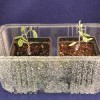Abstract
Grafting is a horticultural technology that combines two plants, the scion and the rootsock, to create a plant with desirable features from both parts. In the United States, the use of vegetable grafting in field production remains limited, although 70% of the total hydroponic greenhouse tomato area uses grafted seedlings. Large, commercial grafting operations use controlled-environment growth chambers, but the high cost limits their use in most small-scale grafting operations. Healing chambers are an alternative solution that provides proper healing at a lower cost for growers and researchers. This 5-page fact sheet was written by Monica Ozores-Hampton and Aline Coelho Frasca, and published by the UF Department of Horticultural Sciences, October 2013.
HS1232/HS1232: Healing Chamber for Grafted Vegetable Seedlings in Florida (ufl.edu)
References
Black, L.L., D.L. Wu, J.F. Wang, T. Kalb, D. Abbass, and J.H. Chen. 2003. "Grafting Tomatoes for Production in the Hot-wet Season." Asian Veg. Res. Dev. Ctr. Pub #03-551.03 July 2013. http://www.ces.ncsu.edu/fletcher/programs/ncorganic/research/grafting.pdf
Hassel, R.L., F. Memmot, and D.G. Liere. 2008. "Grafting Methods for Watermelon Production." HortScience 43:1677-1679. https://doi.org/10.21273/HORTSCI.43.6.1677
Johnson, S.J. and C.A. Miles. 2011. "Effect of Healing Chamber Design on the Survival of Grafted Eggplant, Tomato, and Watermelon." HortTechnology 21:752-758. https://doi.org/10.21273/HORTTECH.21.6.752
Johnson, S., P. Kreider, and C. Miles. 2011a. Vegetable Grafting - Eggplants and Tomatoes. Washington State Univ., WSU Mount Vernon Northwestern Washington Res. Ext. Ctr., Fact Sheet FS052E. 03 July 2013. http://cru.cahe.wsu.edu/CEPublications/FS052E/FS052E.pdf
Johnson, S., P. Kreider, and C. Miles. 2011b. Vegetable Grafting - The Healing Chamber. Washington State Univ., WSU Mount Vernon Northwestern Washington Res. Ext. Ctr., Fact Sheet FS051E. 03 July 2013. http://cru.cahe.wsu.edu/CEPublications/FS051E/FS051E.pdf
Kleinhenz, M.D. 2011. Major Factors in Preparing Grafted Vegetable Plants Successfully. The Ohio State Univ., Ohio Agricultural Res. Dev. Ctr. 03 July 2013. http://hcs.osu.edu/vpslab/major-factors-preparing-grafted-vegetable-plants-successfully
Kubota, C., M.A. McClure, N. Kokalis-Burelle, M.G. Bausher, and E.N. Rosskopf. 2008. "Vegetable Grafting: History, Use, and Current Technology Status in North America." HortScience 43:1664-1669. https://doi.org/10.21273/HORTSCI.43.6.1664
Kubota, C. 2010. Healing Grafted Seedlings. The Univ. Arizona, 26 July 2013. http://cals.arizona.edu/grafting/healing
Lee, S.G. 2007. "Production of High Quality Vegetable Seedling Grafts." Acta Hort. 759:169-174. https://doi.org/10.17660/ActaHortic.2007.759.12
Lee, J.M., C. Kubota, S.J. Tsao, Z. Bie, P.H. Echevarria, L. Morra, and M. Oda. 2010. "Current Status of Vegetable Grafting: Diffusion, Grafting Techniques, Automation. Scientia Hort. 127:93-105. https://doi.org/10.1016/j.scienta.2010.08.003
Oda, M. 2007. "Vegetable Seedling Grafting in Japan." Acta Hort. 759:175-180. https://doi.org/10.17660/ActaHortic.2007.759.13
Ozores-Hampton, M., C.S. Vavrina, and A. Coelho Frasca. 2012. Growing Heirloom Tomato Varieties in Southwest Florida. Gainesville: University of Florida Institute of Food and Agricultural Sciences. http://edis.ifas.ufl.edu/hs174 https://doi.org/10.32473/edis-hs174-2012
Zhao, X. and E.H. Simonne. 2008. "Introducing Grafting Technology to the Florida Tomato Industry: Potential Benefits and Challenges." Proc. Florida Tomato Inst. 525:9-11

